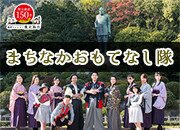1 About “Meiji Restoration 150th Anniversary Countdown Project”
The Meiji Restoration comprises a chain of revolutionary political transformations that led to the demise of the Edo Shogunate (1) and the formation of a modern state.
Satsuma Domain (present day Kagoshima Prefecture) served as the driving force in the movement.
Through the Anglo-Satsuma War in 1863, which stemmed from the Namamugi Incident in Yokohama in the previous year, Satsuma realized the apparent superiority of science technologies and weaponry of the West, and how difficult it was for the government to maintain an isolation policy by driving out the foreign powers. In a dramatic policy shift, Satsuma began to adopt elements of Western civilization and moved toward the overthrow of the Edo Shogunate and the opening of the new era of “Meiji” in 1868.
The year 2018 marks the 150th anniversary of the Meiji Restoration.
From 2012 through 2018, Kagoshima City will carry out “Meiji Restoration 150th Anniversary Projects,” which comprise various programs such as an event to review the path of the Satsuma Domain in turbulent times until the Meiji Restoration.
2 Chronology of the Meiji Restoration
| Major incidents related to the Satsuma Domain | Major incidents in the world | |
|---|---|---|
| 1862 | Namamugi Incident (Yokohama) | The London World Exposition (U.K.) |
| 1863 | The Anglo-Satsuma War | The Emancipation Proclamation (U.S.) |
| 1864 | The establishment of Kaiseijo (Institute for the Study of Western Books) | The end of the Taiping Rebellion (China) |
| 1865 | Dispatch of the Satsuma students to the U.K. | End of the American Civil War (U.S.) |
| 1866 | Conclusion of the Satsuma-Choshu Alliance / Completion of the Shuseikan Machinery Factory | Austro-Prussian War (War between the German Confederation and the Austria Empire) |
| 1867 | Opening of the Kagoshima Spinning Mill / Completion of the Foreign Engineers’ Residence for the Kagoshima Spinning Mill | Paris Exposition (in France) |
| 1868 | The Meiji Restoration |
3 Historical figures from Satsuma
-

-
Saigo Takamori (1)
Saigo was born in the castle town of Shita-Kajiya-machi. Though he served as a low-ranking samurai retainer, he was recognized by the then Satsuma Lord Shimadzu Nariakira, who recruited him as his aide. After having been banished to the remote islands twice, he was finally pardoned and was recalled to Kagoshima in 1864. He lead the Satsuma Domain in the Kinmon Incident (Kinmon no hen) to successfully defend the Imperial Palace in Kyoto from the rebellion led by the Choshu Domain. He then retained a key role in forming the Satsuma-Choshu Alliance—a military alliance between archrivals against the Edo Shogunate—and a civil war against the Edo Shogunate (The Boshin War). He is one of the greatest of figures who represent Kagoshima.
-

-
Okubo Toshimichi (1)
Okubo was born in the town of Korai-cho, but later moved to Shita-Kajiya-machi. Entrusted by the then Satsuma lord Shimadzu Hisamitsu, he served as the facilitator in the negotiation between Satsuma and the U.K. after the Anglo-Satsuma War. He later steered the Satsuma Domain toward the overthrow of the Edo Shogunate. After the establishment of the Meiji government, he was appointed Home Lord and promoted the modernization of the country. Along with Saigo Takamori and Kido Takayoshi, he is recognized as one of the three main architects behind the Meiji Restoration.
-

-
Komatsu Tatewaki (1)
He was adopted into the high-ranking samurai Komatsu Family when he was 20. He served as the chief retainer for the Satsuma Domain at the age of 27 before becoming the deputy lord. He was the advocate of low-ranking men such as Saigo Takamori and Okubo Toshimichi, and took great initiative in governing the domain. He also represented the Satsuma Domain at the conclusion of the Satsuma-Choshu Alliance and Taisei Hokan—the restoration of imperial rule and the end the Tokugawa Shogunate. He died at the age of 34 without fulfilling his life ambition.
-

-
The Princess Atsuhime (Tenshoin) 1
Atsuhime was born to the Imaizumi Shimadzu Family of the Shimadzu Clan. She was adopted by the Satsuma Lord Shimadzu Nariakira and then became the wife of the 13th Shogun Tokugawa Lesada. She managed O-oku—the ladies’ chambers in the inner palace of the Edo Castle—during the turbulent times at the end of the Tokugawa Shogunate. When the Boshin War between the new government and the ruling Tokugawa Shogunate took place in 1868, Atsuhime made every effort for the continuation of the of the Tokugawa Family together with Seikanin (Princess Kazunomiya, wife of the 14th Shogun Lemochi).
-

-
Shimadzu Nariakira 1
He was born at the Satsuma Domain’s estate in Edo as the first child of Shimadzu Narioki, the 27th in line of the Shimadzu lord family of the Satsuma Domain. Soon after becoming the Satsuma lord in 1851, he began to promote political reforms for the purpose of increasing wealth and military power. As part of his efforts, he adopted Western civilization and launched the Shuseikan Project in Iso where he constructed an industrial complex comprising a reverberatory furnace and a blast furnace. He recruited excellent human resources regardless of social status and the domain they were from. However, he died suddenly at the aged of 49.











